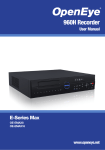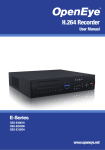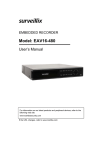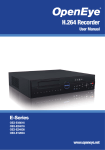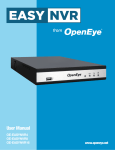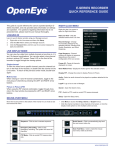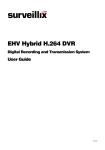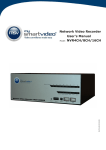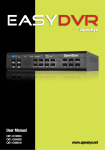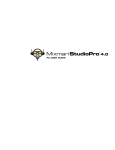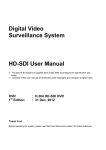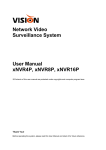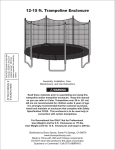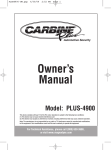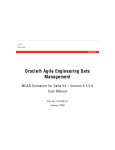Download PoE NVR Recorder
Transcript
PoE NVR Recorder User Manual E-Series PoE NVR OE-ENVRPOE4 OE-ENVRPOE8 OE-ENVR16 www.openeye.net OpenEye® OE-ENVR E-Series Embedded Recorders User Manual Manual Edition 33086AA – MARCH 2015 ©2015, OpenEye All Rights Reserved. No part of this document may be reproduced in any means, electronic or mechanical, for any purpose, except as expressed in the Software License Agreement. OPENEYE shall not be liable for technical or editorial errors or omissions contained herein. The information in this document is subject to change without notice. The information in this publication is provided “as is” without warranty of any kind. The entire risk arising out of the use of this information remains with recipient. In no event shall OPENEYE be liable for any direct, consequential, incidental, special, punitive, or other damages whatsoever (including without limitation, damages for loss of business profits, business interruption or loss of business information), even if OPENEYE has been advised of the possibility of such damages and whether in an action or contract or tort, including negligence. This software and documentation are copyrighted. All other rights, including ownership of the software, are reserved to OPENEYE. OPENEYE and OpenEye, are registered trademarks of OPENEYE in the United States and elsewhere. All other brand and product names are trademarks or registered trademarks of the respective owners. OpenEye products may include open source software that are subject to GNU GPL (General Public License), GNU LGPL (Lesser General Public License), and other similar licensing models. If you would like a copy of the source code, as governed by the GPL and LGPL, please send, by registered mail, a certified check for $15.00 to cover production and shipping costs. A CD with the applicable GPL and LGPL source code will be mailed to you. This offer is good for three years from the original date of purchase. Mail To: OpenEye ATTN Open Source Compliance, 23221 E Knox Ave, Liberty Lake WA 99019. The following words and symbols mark special messages throughout this guide: Text set off in this manner indicates information that is necessary for proper operation of the product. Text set off in this manner indicates information that may be helpful. Text set off in this manner indicates that failure to follow directions could result in damage to equipment or loss of information. OPENEYE Liberty Lake, WA ● U.S.A. 33086AA 3 IMPORTANT SAFEGUARDS 1. Read Owner’s Manual – After unpacking this product, read the owner’s manual carefully, and follow all the operating and other instructions. 2. Power Sources – This product should be operated only from the type of power source indicated on the label. If not sure of the type of power supply to your home or business, consult product dealer or local power company. 3. Ventilation – Slots and openings in the cabinet are provided for ventilation and to ensure reliable operation of the product and to protect it from overheating, and these openings must not be blocked or covered. The product should not be placed in a built-in installation such as a bookcase or rack unless proper ventilation is provided or OpenEye’s instructions have been adhered to. 4. Heat – The product should be situated away from heat sources such as radiators, heat registers, stoves, or other products that produce heat. 5. Water and Moisture – Do not use this product near water. Do not exceed the humidity specifications for the product as detailed in the Appendix section in this manual. 6. Cleaning – Unplug this product from the wall outlet before cleaning. Do not use liquid cleaners or aerosol cleaners. Use a damp cloth for cleaning. 7. Power Cord Protection – Power-supply cords should not be routed so that they are likely to be walked on or pinched by items placed against them, paying particular attention to cords at plugs, receptacles, and the point where they exit the product. 8. Overloading – Do not overload wall outlets; extension cords, or integral convenience receptacles as this can result in a risk of fire or electrical shock. 9. Object and Liquid Entry Points – Never insert foreign objects into the recorder, other than the media types approved by OpenEye, as they may touch dangerous voltage points or short-out parts that could result in a fire or electrical shock. Never spill liquid of any kind on the product. 10. Accessories – Do not place this product on an unstable cart, stand, tripod, bracket, or table. The product may fall, causing serious personal injury and serious damage to the product. 11. Disc Tray – Keep fingers well clear of the disc tray as it is closing. Neglecting to do so may cause serious personal injury. 12. Burden – Do not place a heavy object on or step on the product. The object may fall, causing serious personal injury and serious damage to the product. 13. Disc – Do not use a cracked, deformed, or repaired disc. These discs are easily broken and may cause serious personal injury and product malfunction. 14. Replaceable Batteries – CAUTION: Risk of Risk of Explosion if Battery is replaced by an Incorrect Type. Dispose of Used Batteries According to the Instructions. 15. Grounded Outlet – This equipment shall be connected to a properly grounded outlet. 16. Outlet Location – This equipment must be installed within six feet of an easily accessible outlet. 17. Damage Requiring Service – Unplug the unit from the outlet and refer servicing to qualified service personnel under the following conditions: 4 When the power-supply cord or plug is damaged. If liquid has been spilled, or objects have fallen into the unit. If the unit has been exposed to rain or water. If the unit does not operate normally by following the operating instructions. Adjust only those controls that are covered by the operating instructions as an improper adjustment of other controls may result in damage and will often require extensive work by a qualified technician to restore the unit to its normal operation If the unit has been dropped or the enclosure has been damaged. When the unit exhibits a distinct change in performance - this indicates a need for service. 18. Servicing – Do not attempt to service this product unless instructed to by an OpenEye engineer. Opening or removing covers may expose the user to dangerous voltage or other hazards. Refer all servicing to qualified personnel. 19. Replacement Parts – When replacement parts are required, be sure the service technician has used replacement parts specified by OpenEye or have the same characteristics as the original part. Unauthorized substitutions may result in fire, electric shock or other hazards. 20. Safety Check – Upon completion of any service or repairs to this unit, ask the service technician to perform safety checks to determine that the unit is in proper operating condition. NOTES ON HANDLING Please retain the original shipping carton and/or packing materials supplied with this product. To ensure the integrity of this product when shipping or moving, repackage the unit as it was originally received from OpenEye. Do not use volatile liquids, such as aerosol spray, near this product. Do not leave rubber or plastic objects in contact with this product for long periods of time. They will leave marks on the finish. The top and rear panels of the unit may become warm after long periods of use. This is not a malfunction. NOTES ON LOCATING Place the unit on a level surface. Do not use it on a shaky or unstable surface such as a wobbling table or inclined stand. If this unit is placed next to a TV, radio, or VCR, the playback picture may become poor and the sound may be distorted. If this happens, place the recorder away from the TV, radio, or VCR. NOTES ON CLEANING Use a soft dry cloth for cleaning. For stubborn dirt, soak the cloth in a weak detergent solution, wring well and wipe. Use a dry cloth to wipe it dry. Do not use any type of solvent, such as thinner and benzene, as they may damage the surface of the recorder. If using a chemical saturated cloth to clean the unit, follow that product’s instructions. 33086AA 5 NOTES ON MAINTENANCE This recorder is designed to last for long periods of time. To keep the recorder always operational we recommend regular inspection maintenance (cleaning parts or replacement). For details contact the nearest dealer. NOTES ON MOISTURE CONDENSATION Moisture condensation could damage the recorder. Read the following information carefully. Moisture condensation might occur under the following circumstances: When this product is brought directly from a cool location to a warm location. When this product is moved to a hot and humid location from a cool location. When this product is moved to a cool and humid location from a warm location. When this product is used in a room where the temperature fluctuates. When this product is used near an air-conditioning unit vent. When this product is used in a humid place. Do not use the recorder when moisture condensation may occur. If the recorder is used in such a situation, it may damage discs and internal parts. Remove any CD discs, connect the power cord of the recorder to the wall outlet, turn on the recorder, and leave it for two to three hours. After two to three hours, the recorder will warm up and evaporate any moisture. Keep the recorder connected to the wall outlet and moisture will seldom occur. WARNING TO REDUCE THE RISK OF ELECTRICAL SHOCK, DO NOT EXPOSE THIS APPLIANCE TO RAIN OR MOISTURE. DANGEROUS HIGH VOLTAGES ARE PRESENT INSIDE THE ENCLOSURE. DO NOT OPEN THE CABINET. REFER SERVICING TO QUALIFIED PERSONNEL ONLY. CAUTION RISK OF ELECTRIC SHOCK DO NOT OPEN CAUTION: TO REDUCE THE RISK OF ELECTRIC SHOCK, DO NOT REMOVE COVER (OR BACK). NO USER-SERVICEABLE PARTS INSIDE. REFER SERVICING TO QUALIFIED SERVICE PERSONNEL. 6 EXPLANATION OF GRAPHICAL SYMBOLS The lightning flash with arrowhead symbol, within an equilateral triangle, is intended to alert the user to the presence of un-insulated "dangerous voltage" within the product enclosure that may be of sufficient magnitude to constitute a risk of electric shock to persons. FCC STATEMENT This equipment has been tested and found to comply with the limits for a Class A digital device, pursuant to Part 15 of the FCC Rules. These limits are designed to provide reasonable protection against harmful interference when the equipment is operated in a commercial environment. This equipment generates, uses, and can radiate radio frequency energy and, if not installed and used in accordance with the instruction manual, may cause harmful interference to radio communications. Operation of this equipment in a residential area is likely to cause harmful interference in which case the user will be required to correct the interference at his own expense. EN 55022 Class A Notice WARNING This is a class A product. In a domestic environment this product may cause radio interference in which case the user may be required to take adequate measures. 33086AA 7 Standard Warranty OpenEye warrants all new products to be free from defects in workmanship and material under normal use for a period of two years after the date of purchase. Any defective product that falls under this warranty will, at OpenEye's discretion, be repaired or replaced at no additional charge. OpenEye may elect to replace defective products with new or factory reconditioned products of equal or greater value. Repairs made necessary by reason of misuse, alteration, normal wear, or accident are not covered under this warranty. Exceptions to this are listed below: Three Years on all Digital Recorders Three years on all analog fixed cameras All products shall be covered by a one year advance replacement warranty*. OpenEye will warrant all otherwise out of warranty replacement parts and repairs for 90 days from the date of OpenEye shipment. The above warranty is the sole warranty made by OpenEye and is in lieu of all other warranties by OpenEye express and implied, including without limitation the warranties of merchantability and fitness for a particular purpose. Under no circumstances will OpenEye be liable for any consequential, incidental, special or exemplary damages arising out of or connected with the sale, delivery, use or performance of the product, even if OpenEye is apprised of the likelihood of such damages occurring. In no event shall OpenEye liability exceed the purchase price of the product. This warranty gives you specific legal rights and you may also have other rights which vary from state to state or country to country. *Requires corresponding security deposit. Advanced Replacement limited to components only outside of the USA and Canada. 28574AG For the most up to date information visit www.openeye.net. 8 Table of Contents .............................................................................................................................. 9 Introduction ...................................................................................................................................... 12 Product Description ........................................................................................................ 12 Features.......................................................................................................................... 13 USB Flash Drive Approved List ...................................................................................... 13 Turning on the Recorder ................................................................................................. 14 Using the Front Panel to Turn On/Off the Recorder................................................. 14 Logging In for the First Time ........................................................................................... 14 Installation ........................................................................................................................................ 15 Front Panel Controls ....................................................................................................... 15 4, 8, and 16 Channel ............................................................................................... 15 Rear Panel Connectors................................................................................................... 16 4 Channel ................................................................................................................ 16 8 Channel ................................................................................................................ 17 16 Channel .............................................................................................................. 18 Connection Guide ........................................................................................................... 19 Connecting the Monitor............................................................................................ 19 Connecting to a Network ......................................................................................... 19 Connecting Audio .................................................................................................... 19 Connecting to a Sensor Input .................................................................................. 19 Connecting to a Relay Output .................................................................................. 19 Quick SETUP Instructions .............................................................................................. 20 Setup................................................................................................................................................. 21 Setup Menus................................................................................................................... 21 System ............................................................................................................................ 22 System Setup .......................................................................................................... 22 Upgrade Firmware ................................................................................................... 23 Disk Setup ............................................................................................................... 24 Format .............................................................................................................. 24 HDD Overwrite ................................................................................................. 25 Check ............................................................................................................... 25 SMART Check .................................................................................................. 26 User Setup ............................................................................................................... 27 Adding / Changing a User ................................................................................ 28 Configuration ........................................................................................................... 29 Shutdown ................................................................................................................. 29 Camera ........................................................................................................................... 30 Camera Setup ......................................................................................................... 30 Color Setup (Adjust) ......................................................................................... 30 33086AA 9 Sequence Setup ...................................................................................................... 31 Monitor Setup .......................................................................................................... 31 Record ............................................................................................................................ 32 Recording Setup ...................................................................................................... 32 IP Camera ........................................................................................................ 32 Schedule .......................................................................................................... 33 Holiday Setup ................................................................................................... 35 Audio ................................................................................................................ 35 Instant Recording ............................................................................................. 36 Instant Backup:.......................................................................................... 36 Motion/Event Setup ................................................................................................. 37 Input ................................................................................................................. 37 Setting Up Motion Detection Recording............................................................ 38 Sensor .............................................................................................................. 39 Action ............................................................................................................... 40 Alarm Monitor ................................................................................................... 41 Network........................................................................................................................... 42 Network Setup ......................................................................................................... 42 Serial Setup ............................................................................................................. 43 E-mail Setup ............................................................................................................ 44 ReportStar ............................................................................................................... 45 Information ...................................................................................................................... 46 System Log View ..................................................................................................... 46 Status View .............................................................................................................. 47 Version View ............................................................................................................ 49 Camera Discovery .......................................................................................................... 50 Finding PoE and Network IP Cameras .................................................................... 50 Adding Cameras to Display Channels .............................................................. 50 Operation .......................................................................................................................................... 51 Login ............................................................................................................................... 51 Default Administrator Log In .................................................................................... 51 Live Display Mode .......................................................................................................... 51 Channel Selection.................................................................................................... 51 Icons ........................................................................................................................ 52 Mouse-Over Menu ................................................................................................... 53 Popup Menu ............................................................................................................ 54 No Signal ................................................................................................................. 54 No Permission ......................................................................................................... 54 PTZ .......................................................................................................................... 55 PTZ Popup Menu ............................................................................................. 55 Create PTZ Preset Position ....................................................................... 55 Search ............................................................................................................................ 56 Searching Recorded Data ....................................................................................... 56 Graphic Search ........................................................................................................ 56 Quick Backup in Search Mode ................................................................................ 58 10 Express Search ....................................................................................................... 58 Event Search ........................................................................................................... 58 Jump to First Saved Data ........................................................................................ 58 Jump to Last Saved Data ........................................................................................ 58 Daylight Saving Search ........................................................................................... 59 Search Popup Menu ................................................................................................ 59 EXPORT ......................................................................................................................... 60 Manual Export ......................................................................................................... 60 Using the Backup Player................................................................................................. 61 Controlling Backup Player ....................................................................................... 61 Setup and Save Functions....................................................................................... 62 Play Back Backup Image ......................................................................................... 62 Screen Division Buttons ........................................................................................... 63 Save Settings.................................................................................................................. 64 Save Settings .......................................................................................................... 64 Import Settings......................................................................................................... 64 Remote Software ............................................................................................................................. 65 RADIUS Overview .......................................................................................................... 65 Installing RADIUS on your PC ................................................................................. 65 Web Viewer Overview..................................................................................................... 66 Connecting to a Recorder Using Web Viewer ......................................................... 67 Search Video Using Web Viewer ............................................................................. 67 Performing a Basic Search ............................................................................... 68 Status Search ................................................................................................... 68 Performing a Status Search ...................................................................... 68 Print .................................................................................................................. 69 Save ................................................................................................................. 69 Digital Verifier Overview.................................................................................................. 70 Using the Digital Verifier .......................................................................................... 70 Appendix .......................................................................................................................................... 71 Button Index.................................................................................................................... 71 LED Status Indicators .............................................................................................. 71 Function Buttons ...................................................................................................... 72 Recorder Specifications .................................................................................................. 74 33086AA 11 The newest addition to the E-Series embedded recorder lineup, E-Series NVR, merges powerful high definition network video recording with the ease of “Plug and Play” installation. Housed in a compact chassis, the E-Series NVR supports OpenEye Power over Ethernet (PoE) cameras, enabling fast and easy access to recording resolutions up to 1080p. Preconfigured for continuous recording and DDNS, with no additional setup required, the ESeries NVR offers quick search, setup, and backup features. All E-Series recorders use an embedded Linux operating system, which provides stability and protection from viruses. E-Series NVR recorders are ready for fast and seamless integration within your existing IT infrastructure. These recorders are designed to offer unparalleled stability, security, and ease of use in each model. Your security investment has never been easier to maintain. Multiple users may connect through any network for simultaneous live viewing and digital search. This powerful software enables users to establish recording schedules, create motion detection zones, and use PTZ controls on available attached video input devices. With the latest advancements in the E-Series firmware, indexing and searching your video archive is fast and easy. Multiple remote users can view live virtual multiplexed video, search, and backup data for offsite video storage as well as configure the recorder and perform remote software updates using RADIUS video management software. OpenEye’s suite of applications allows you to remotely manage recorder settings and permissions, monitor alarm and sensor events offsite, create custom maps of facilities, and search or backup recorded video. 12 The E-Series NVR includes the following features: 8/16 composite video input connectors Compatible with color (NTSC or PAL) and B&W video sources Multiple search methods (Calendar, Event) Records up to 240 NTSC Images Per Second (IPS) Live real time video display (NTSC: 480 IPS / PAL: 400 IPS) Continuous recording with disk overwrite mode Continuous recording during backup, search, and remote access Unique motion recording configuration for each camera channel when using OpenEye cameras Custom motion detection areas for each camera channel when using OpenEye cameras Multiple recording modes (Manual / Schedule / Event) Audio recording and playback (from cameras with MIC input) 4 built-in sensor inputs (Normally Open or Normally Closed) 1 built-in relay outputs (Normally Open or Normally Closed) Remote access PTZ camera control when using OpenEye cameras These USB flash drives have been tested and approved to work with E-Series recorders. Other USB flash drives may also work with E-Series recorders but have not yet been tested. 33086AA Manufacturer Model SanDisk Cruzer Talent Flash Corsair Voyager Lexar JumpDrive Kingston Traveler 13 1. Connect IP cameras to the PoE switch (4 and 8 channel models have switches located on the back of the recorder) OR Connect the recorder to a PoE switch or a network with cameras that the recorder can access (16 channel model needs the PoE switch connected through the Network port on the back of the recorder). 2. Connect a network cable and a monitor. 3. Connect the power cable to the recorder and wait until the main screen is displayed on the connected monitor; this process will take approximately two minutes. See the Connection Guide section for more details. Using the Front Panel to Turn On/Off the Recorder To start the recorder: Press and hold the POWER button on the front panel of the recorder until the lights start to flash. To shutdown the recorder: Click MENU on the hover menu, and then click SHUTDOWN. OR Press and hold the POWER button on the front panel of the recorder, log in when prompted and select OK to shut down. Only authorized users can shut down the recorder. Default administrative log in information: ID: admin Password: 1234 14 4, 8, and 16 Channel Live Setup Up Exit Power Recording LED Right Search PTZ Backup Replay/ Pause Power LED Network LED Left Record 33086AA Search Backward Search Forward Down USB 15 The rear panel of the recorder contains virtually all of the connectors you will be using. The diagram below shows the location and description of each connector. 4 Channel Network Camera PoE Ports 48vDC Power 16 Service Port (manufacturer use only) Audio Out HDMI Out VGA Out Network Port USB Port Alarm Input / Output e-SATA Port (for external storage only) 8 Channel Network Camera PoE Ports 48vDC Power 33086AA Service Port (manufacturer use only) Audio Out HDMI Out VGA Out Network Port USB Port Alarm Input / Output e-SATA Port (for external storage only) 17 16 Channel Service Port (manufacturer use only) Audio Out 18 HDMI Out VGA Out Network Port USB Port Alarm Input / Output e-SATA Port (for external storage only) 112vDC Power Connecting the Monitor There are two available monitor outputs on E-Series NVR recorders. HDMI output for HDMI monitor VGA output for VGA monitor Connecting to a Network Use the RJ45 jack on the rear of the recorder when connecting to a network or PoE switch. Connecting Audio To listen to live or recorded audio connect the Audio Out Port to an amplified speaker system. The audio output is a line level source which requires an amplified speaker system. Connecting to a Sensor Input To make connections on the Alarm Connector Strip: Loosen the tension screw and insert the wire into the hole. Tighten the tension screw to secure the wire. To disconnect the wire: Loosen the tension screw and pull the wire out of the hole. Sensor In Use external devices to send a signal to the recorder when an event occurs. Mechanical or electrical switches can be wired to the Sensor In and Ground (G) connectors. All connectors marked G are common. Connect the ground side of the sensor input and/or alarm output to the G connector. Connecting to a Relay Output To make connections on the Alarm Connector Strip: Loosen the tension screw and insert the wire into the hole. Tighten the tension screw to secure the wire. To disconnect the wire: Loosen the tension screw and pull the wire out of the hole. Alarm Out The recorder can activate external devices such as buzzers or lights. Connect the external device to the Alarm Out and Ground (G) connectors. See Sensor Setup in the manual for more details. 33086AA 19 1. Turn on the recorder. See the Turning on the Recorder section of this manual for more details. 2. Log in. The default password is 1234 but it is recommended to change the password after initial setup to ensure only authorized use of the recorder. 3. Complete System Setup to set up the date, time and system ID. See the System section for more details. 4. Complete Disk Setup to set overwrite options and enable SMART Check. See the Disk Setup section for more details. 5. Complete User Setup to change the Admin password and add additional users. See the System > User Setup section for more details. 6. Complete Camera Setup for all attached cameras. See the Camera section for more detail. 7. Create a recording schedule. See the Record section for more details. 8. Complete Sensor Setup to enable any external devices connected to sensor inputs or relay outputs. See the Record > Motion/Event section for more details. 9. Complete Motion/Event Setup to trigger recording on an event: motion, sensor, video loss. See the Motion/Event section for more details. The recorder is now configured to record, search, and playback video. 20 Use the setup menus to configure all of the recorder settings, schedule recording, networking and shutdown. Connect a USB mouse to the recorder to navigate setup menus and recorder functions. See the Logging In for the First Time section if entering setup for the first time. If you do not have a USB mouse, you can press the SETUP key on the front of the recorder to enter the setup menus and log in. Use the and keys on the front of the recorder to navigate individual menus, and use the and keys to select a new setup menu. The instructions in this manual direct you in the use of a mouse to navigate the setup and functions of the recorder. You may also use the keys on the front of the recorder. 33086AA 21 System Setup 1. Click MENU on the hover menu, and then click SETUP. 2. Click SYSTEM, and then click SYSTEM SETUP. 3. Click SAVE to save your updates. Language - ENGLISH / SPANISH / FRENCH [User Selectable]. DVR ID - Required for the operation of multiple units when using a PTZ keyboard joy stick. Each system must have a unique ID to function properly. Date Format - US (MM-DD-YYYY) / EURO (DD-MM-YYYY) / ASIA (YYYY-MM-DD) – [User Selectable]. Date – Click the DATE, and then click the values to adjust. Click SAVE when you are finished. Time – Click the TIME and then click the values to adjust. Click SAVE when you are finished. Time Zone - Click the TIME ZONE, and then select your desired Time Zone. Click OK to save. The date and time must be set manually; changing the time zone will not automatically change the Time/Date display. 22 System Setup Continued Use DST – After completing the Time Zone setup, click the USE DST value (ON or OFF) to enable or disable Daylight Saving Time. NTP Type – Click NTP TYPE to enable or disable a Network Time Protocol. In the NTP Type window, enable NTP SERVER, and then type your desired NTP Server URL. Click SYNC NOW, and then click OK. Keypad Beep - Enables or disables audible keypad touch confirmation. (ON / OFF) Auto Log Off – This feature will close the Setup Menu after a predetermined period of inactivity.(1 ~ 10 min, OFF). S/W Upgrade – Start firmware upgrade from selected USB media. Upgrade Firmware 1. Connect your USB device containing the upgrade file. 2. Click MENU on the hover menu and select SETUP. 3. Click SYSTEM, and then click SYSTEM SETUP. 4. Click S/W UPGRADE to open the UPGRADE FIRMWARE window. 5. Click SCAN. 6. Click OK to start the upgrade. You will be prompted to confirm the firmware upgrade and upon clicking YES, the recorder will begin the upgrade and then notify you of the necessary restart. Upon confirmation of restart, the recorder will automatically restart. 33086AA 23 Disk Setup Shows installed Hard Disk Drives and the status of other attached storage devices. To format a Hard Drive or USB device, select the appropriate device, click FORMAT, and then click YES. Refer to the list of Approved USB Flash Drives in the Introduction of this manual. To refresh the list of connected USB devices, click RESET. All USB devices must be formatted as FAT32 before using with the recorder. When formatting a drive, all video and other data stored on that drive will be permanently erased and cannot be recovered. 24 Sets options for overwriting data when the Hard Disk Drive becomes full. Enable HDD OVERWRITE to allow the recorder to write over previously recorded data, starting with the oldest date, when the HDD is full. If set to DISABLE the recorder will not record any new data once the HDD becomes full. Enable a DISK FULL WARNING for notification when the HDD becomes full and HDD Overwrite is disabled. Checks the HDD for errors or failure. 33086AA 25 S.M.A.R.T. = Self Monitoring Analysis & Reporting Technology. Enable SMART Check to detect signs of HDD failure. 1. Set ENABLE S.M.A.R.T. to ENABLE or DISABLE. 2. Set a CHECK INTERVAL between 1 and 24 hours. 3. Define a TEMP THRESHOLD and select Celsius or Fahrenheit. The recommended upper optimum operating temperature for the HDD is between 104° F to 122° F (40° C to 50° C). 4. Select a S.M.A.R.T. WARNING to be activated when the HDD reaches the defined threshold. 5. Click SAVE to save your settings. Select HDD INFORMATION and press ENTER to view the current HDD and USB drive information. 26 User Setup Use the User Setup to Add or Delete users. 33086AA 27 To add a new user: 1. Click MENU on the hover menu and click SETUP. 2. Click SYSTEM, and then click USER SETUP. 3. Click ADD/CHANGE. 4. Type a USER name. 5. Type a PASSWORD and CONFIRM for the new user. 6. Select the FUNCTION and SETUP access options for the user. 7. Select which cameras will be visible to the user in LIVE and PLAYBACK modes. SHUT DOWN – Allow the user to shut down or restart the recorder. EXPORT – Allow the user to perform an export or backup saved data. USE CD/DVD/USB - Allow the user to use the DVD Drive or USB port. This is a server-side feature only. SEARCH – Allow the user to use the search functions to locate video and access video from the current day using the REPLAY key on the front panel. EXPORT VIEWER – Allow the user to include a copy of the Backup Viewer application when a local backup is made. This is a server-side feature only. NETWORK CONNECTION – Allow the user to log in using Web Viewer. PTZ – Allow the user control of any connected PTZ cameras. HEALTH CHECK – Allow the user to use the Health Check function of RADIUS to connect to and monitor the recorder. INSTANT RECORDING – Allow the user to activate the Instant Recording feature. SETUP ACCESS PERMISSION – Allow the user to access the selected portion of the setup menu. LIVE & PLAYBACK – Allow the user to view live and recorded data for only the selected cameras. 28 Configuration Import and Export current settings. See details in the Save Settings section. Shutdown Use Shutdown to safely shutdown the system. 1. On the hover menu, click MENU, and then click SETUP. 2. Click SYSTEM, and then click SHUTDOWN. 3. Click OK. 4. Turn the power off when shutdown is complete by unplugging the power adapter cord on the back of the recorder. Improper shut down of the system can cause data loss and system corruption. 33086AA 29 Camera Setup CH – Camera Channels NAME – Use the on-screen keyboard to enter a camera name [user defined]. HIDDEN – ON/OFF, make the camera viewable to only specific users. HIDDEN on the CAMERA SETUP page hides cameras from the main monitor (VGA/HDMI) when no users are logged in. To hide cameras from users, clear camera check boxes on the SYSTEM > USER SETUP > ADD/CHANGE. ADJUST – Detailed camera display settings PRIVACY ZONE – ON/OFF, configure a privacy zone for the camera. CAMERA – 1 ~ 16 [camera to apply color settings to] BRIGHTNESS – 0 ~ 20 CONTRAST – 0 ~ 20 COLOR – 0 ~ 20 DEFAULT – Apply default system color settings APPLY ALL – Apply current color settings to all cameras 30 Sequence Setup Spot/Sequence Setup allows you to set the parameters for the SPOT OUT on the recorder and the local live view sequencing. PAGE DWELL TIME: Number of seconds the screen will remain on one screen sequence before moving to another. Monitor Setup VGA RESOLUTION – Set monitor resolution. OSD – Select the items to display on the screen (DATE, TIME, TITLE, PTZ, RECORD, AUDIO). 33086AA 31 Recording Setup IP Cameras allows you to view the status of connected IP cameras. ENABLE – Enable the IP camera (On of Off) MODEL – The IP Camera model (determined by the camera itself) STREAM – Current stream settings IP ADDRESS – Current IP Address of the IP camera SETTING – Adjust the IP camera settings DELETE – Delete the IP camera 32 Set the recording schedule for each camera. 1. On the hover menu, click MENU, and then click SETUP. 2. Click RECORD, and then click SCHEDULE. 3. Select a camera to create a recording schedule, or select ALL. 4. Select your desired RECORD MODE. 5. Click hour block or the day of the week to set the entire day. NO RECORDING No recording. No Color Even if you set recording frames and select ON in RECORD > CAMERA, the recorder will not record anything if you select OFF in RECORD > SCHEDULE. CONTINUOUS Continuous recording. Yellow MOTION MOTION-detection recording. Green In this mode, the unit records only when motion is detected in the motion area, and stops recording when motion is not detected. Adjust motion area settings in RECORD > MOTION/EVENT SETUP > INPUT. If you set motion to OFF in RECORD > MOTION /EVENT CONFGURATION and set CONT + MOT in SETUP > RECORD > SCHEDULE the recorder will NOT record when motion is detected. 33086AA 33 SENSOR Sensor-activated recording. Orange In sensor mode, the unit will record when a sensor is triggered - during DURATION time as set in RECORD > MOTION /EVENT CONFGURATION > ACTION. CONT+MOT Continuous and motion detection recording Sky Blue The unit records in CONTINUOUS mode but switches to MOTION when motion is detected in the motion area. The recorder also will log a Motion Event and send the event to the Remote Monitoring software. If you set motion to OFF in RECORD > MOTION /EVENT CONFGURATION and set CONT + MOT in SETUP > RECORD > SCHEDULE the recorder will NOT record when motion is detected. 34 CONT+SENS Continuous and sensor-activated recording Brown In this mode, the unit records continuously and switches to SENSOR recording mode when a sensor is triggered. The recorder also will log a Sensor Event and send the event to the Remote Monitoring software. MOT+SENS Motion detection and sensor-activated recording. Lilac The recorder will only record when motion is detected or a sensor is triggered. Add a recording schedule for a specific date in HOLIDAY SETUP. You can add up to 32 individual holiday recording schedules. To add a new HOLIDAY schdule: 1. On the hover menu, click MENU, and then click SETUP. 2. Click RECORD, and then click RECORD SETUP. 3. Click SCHEDULE. 4. Create a recording schedule in the H.DAY row. 5. Click HOLIDAY SETUP. 6. Click the DATE, and set your desired holiday date using the on-screen calendar. 7. Click the DESCRIPTION column to type a description or name for this holiday. 8. Click ADD to add the holiday. AUDIO IN – Enable or disable audio recorder from compatible IP cameras with Mic input (ON / OFF). TWO WAY AUDIO – Enable or disable two-way audio (ON / OFF). 33086AA 35 Configure the recording settings for and Instant Backup to use when they are activated. Instant Backup: DEFAULT DURATION – Set the number of minutes to back up (15, 20, 30, 40, 50, 60). If the Default Duration is set to 30 MIN, the recorder will export the last 30 minutes of data when the Instant Backup button is pressed. DEFAULT TARGET – Set the location the recorder will export to (USB). Make sure you have the selected media on hand. PROMPT FOR CONFIRMATION – When enabled, the recorder will prompt the user to confirm the export. PASSWORD PROTECTION – Requires the Admin user to login before Instant Backup will start. 36 Motion/Event Setup Motion / Event Setup has four sections; Input, Sensor, Action, and Alarm Monitor. When an event occurs (Input), the unit records the image according to its settings (Camera Setup) and triggers an alarm (Action). CH – Channels 1-8 will appear by default. To view channels 9-16, click CH. MOTION – Enable or disable motion input (ON / OFF). SENSOR – Associate a sensor with the camera channel. VIDEO LOSS – Associate a channel to monitor for video loss detection. 33086AA 37 Motion detection recording is ON by default on OpenEye cameras, making it easy to configure Motion Detection Recording from the recorder. If you are having difficulty configuring Motion Detection Recording, ensure that the camera Motion Detection is ON. To record data only when motion is detected: 38 1. Click MENU on the hover menu, and then click SETUP. 2. Click RECORD, and then click MOTION/EVENT SETUP. 3. Set MOTION to ON. 4. Set VIDEO LOSS to ON 5. Repeat as necessary for each camera channel. 6. When motion area setup is complete select SAVE to save settings and exit setup. Sensor Setup 1. Set the Sensor TYPE to N/O (Normally Open) or N/C (Normally Closed). 2. Repeat for all sensors. 3. Click SAVE. Alarm Setup 1. Enable or disable the SIGNAL (ON / OFF). 2. Set each alarm TYPE (NO / NC). 3. Repeat for all relays. 4. Click SAVE. Power Off The POWER OFF option is a preset function that triggers an alarm relay when the recorder loses power. This function is preconfigured to set alarm relay No. 1 to ON and N/C. When a power loss occurs, alarm relay No. 4 will open. When power is restored the alarm will close. S.M.A.R.T. Alarm The S.M.A.R.T. ALARM option is a preset function that triggers an alarm relay when the HDD exceeds the temperature threshold configured on the SYSTEM > DISK SETUP > S.M.A.R.T. page. This function is preconfigured to set an alarm relay to ON and N/C. When the HDD exceeds the temperature threshold, the alarm relay will open. When the temperature is at a safe level again the alarm will close. SET and CLEAR are used to test the alarm relay operation. SET is used to manually activate all relays that are set to ON. CLEAR is used to manually deactivate all relays. Hold Video Loss When set, the alarm will stay on when a channel loses video. The alarm will turn off when Video returns. 33086AA 39 CH – Channels 1-8 will appear by default. To view channels 9-16, click CH. Alarm – Associate an alarm relay with a camera channel (OFF / 1). Delay – Set the delay time for relay to activate (0~100 seconds). Duration – Set the duration of the alarm relay (0~100 seconds). Preset – Enable a PTZ camera to move to a preset position when an event occurs (0~100). See PTZ Control for more information.] Notify – Select the type of alarm to associate with this event (BUZZER / POPUP). 40 Send event information to a remote client using the Alarm Monitor software. 1. Set SEND TO ALARM MONITOR to ON. 2. Select the types of events to send to the Emergency Agent (MOTION, SENSOR, MOTION + SENSOR). 3. Type the IP ADDRESS of the remote client. 4. Type the PORT number. The port number selected is the port that Alarm Monitor uses on the remote PC. The port shown in this screen must match the port shown in Emergency Agent or RADIUS and the port must be open on the remote PC. 33086AA 41 Network Setup Configure network settings. Network HOST NAME – Host name for the recorder on the network. NETWORK TYPE – Select STATIC IP to manually define a static IP address. Select DHCP for a DHCP server to assign an IP address automatically. Contact your network administrator for more information. IP ADDRESS – You can set the IP ADDRESS if your network type is set to STATIC. Contact your network administrator for this information. CLIENT CONFIGURATION – Set up the connection ports and Max transfer speed for remote connections. CENTER PORT – E-Series recorders use the Center port and the primary communication port to create remote connections. This port must be the same as the port setting on the remote PC. VIDEO PORT –E-Series recorders use multiple ports to create remote connections. The remote port is user-defined (default 2000), and a secondary port is automatically assigned (default 2002). The recorder assigns the secondary port based on the remote port, in increments of two. (For example, if you set the remote port to 2222, then the secondary port will be 2224.) Verify that all these ports are available when setting up Network Address Translation (NAT) or firewall. WEB PORT – Defines the port that Internet Explorer uses to connect over the web and view video. If this port is changed then the new port must be defined when attempting to web connect. (For example, if your IP address is 10.0.0.5 and you change the web port to 800, then you must type http://10.0.0.5:800 in your browser.) MAX TRANSFER SPEED – Set network bandwidth. This feature is used for slower internet connections to throttle the amount of data the recorder sends across the network at a time. 42 DDNS SERVER – Dynamic Domain Name Service (DDNS) is a service that allows a connection to an IP address using a hostname (URL) address instead of a numeric IP address. Most Internet Service Providers use Dynamic IP Addressing that frequently changes the public IP address of your internet connection; this means that remote connections through RADIUS and Remote would require frequent updates. DDNS automatically redirects traffic to your current IP address when using the hostname address (i.e. oe123456.openeyedvr.com). DDNS SERVER – The current DDNS server. HOST NAME – Hostname for the DDNS server account. ID – Username for the DDNS server account. PASSWORD – Password for the DDNS server account. STATUS – Checks DDNS settings by attempting to communicate with the DDNS Server. Serial Setup Configure connected serial devices. Note: E-Series NVR recorders do not have an RS-232 port for connecting serial devices. TYPE – NONE / EXTERNAL CONTROLLER MODEL – Select appropriate model. Port Information BAUD RATE / DATA BIT / PARITY / STOP BIT 33086AA 43 E-mail Setup The recorder can send an e-mail notification to up to six defined e-mail addresses when an event happens. E-MAIL SERVER – Configure the recorder to use selected e-mail server (DVR / SMTP). OPTION – Define the type of event that will trigger an e-mail notification. MOTION – After a motion alarm is triggered. SENSOR – After a sensor alarm is triggered. VIDEO LOSS – After video loss on a camera POWER – When the recorder is shutdown and restarted. SETUP – When a user accesses Setup. LOG IN – When a user logs in. LOGIN FAIL – After one failed login attempt. DISK FULL – When the HDD reaches the user-defined maximum disk full percentage. See DISK MANAGEMENT – OVERWRITE. S.M.A.R.T. – When the HDD reaches the user-defined maximum temperature. See DISK MANAGEMENT – S.M.A.R.T.. PIC – ON / OFF [Enable to send a picture of the event.] E-MAIL ADDRESS – Enter the e-mail address. 44 ReportStar To enable ReportStar on your recorder during the initial configuration: 1. Click ENABLE REPORTSTAR NOW. To enable ReportStar at any time after the initial configuration, go to NETWORK > REPORTSTAR SETUP and then set ENABLE REPORTSTAR to ON. 33086AA 2. Log in using the admin user account. (default username: admin, password: 1234) 3. Set the CUSTOM DAY/NIGHT TIME. 4. Click SEND to send a test report to ReportStar. 5. To send Alarm Events to ReportStar, set SEND ALARM EVENTS INSTANTLY to ON. 6. To send active updates to ReportStar every 5 minutes, set HEARTBEAT to ON. 7. Click SAVE to save your settings. 45 System Log View Displays system log information. System Log View displays the recent activity of all users on the recorder. You can export and save the System Log to review user activity. 46 Status View Displays status screens for: Disk IP Cameras Audio 33086AA 47 Sensor Network Event 48 Version View Displays system information and software version information for the recorder. 33086AA 49 Finding PoE and Network IP Cameras 1. Click MENU on the hover menu, and then click SETUP. 2. Click CAMERA DISCOVERY. PoE cameras will display automatically, and if the recorder is connected to the network, the Camera Discovery will automatically search the network for IP cameras when opened. 3. Enter the camera USERANEM and PASSWORD. 4. Click SEARCH and the Camera Discovery will search the network for cameras that require permissions. 5. Select an IP camera, and then click GET PROFILE to display additional information about the camera. 1. To display the camera, click and drag the desired camera to the desired channel. OR Click the desired camera, click GET PROFILE, click the CHANNEL to designate a channel, and then click APPLY. 2. 50 Once the channels are configured, click CLOSE. The LOG-IN window will display on the monitor until a user logs in with the correct ID and password. To prevent unauthorized changes to the system settings, the administrator should change the default administrator password and create a User account. Default Administrator Log In The default administrator account login is: USER: admin PASSWORD: 1234 Channel Selection A live image can be selected by pressing corresponding number key on the front panel of the recorder. The images can be seen in real-time in the configuration of 1, 4, 9, 16 channels screen. To toggle through the viewing options press LIVE on the recorder. To select a channel using a mouse, double-click the video image. To return to a previous screen mode after selecting a viewing channel, double-click again. Screen division options are dependent on the maximum number of channels on your recorder. 33086AA 51 Icons In Live mode, icons or messages on the screen indicate the system mode or status. Right-upper corner on each CH. Right-bottom corner on full screen. Continuous Recording No HDD, Smart Alarm & HDD Failure Motion Detection Recording Using Emergency Recording Sensor Activated Recording Using PTZ Continuous + Motion Alarm Recording Warning for exceeding temperature Continuous + Sensor Activated Recording Showing sequence mode Motion Detection + Sensor Activated Recording Showing digital zoom mode Emergency Recording Sensor Activated Motion Detected Audio Channel PTZ Camera If there is no icon in the right upper corner of the live screen mode, it means that the system is not currently recording. If this is the case, you should check the recording schedule or camera setup in the main setup menu. 52 Mouse-Over Menu Move the mouse to the bottom of the monitor in live mode. The hover menu will appear. Channel Division PTZ Controls Pin Tool Dock MENU Menu Camera Channel Camera Discovery Quick Search Screen Division Indicator – Availability (1, 4, 9, or 16 channel display) is dependent on recorder model. When selected, the button will be blue. Sequence – Click to start camera sequence. PTZ Mode – Click to enter PTZ mode. In PTZ mode, you can pan/tilt and zoom by moving the mouse pointer, referred to as a virtual joystick. Camera Discovery – Opens the camera discovery menu to search for IP cameras. Quick Search – Click to automatically play back the most recent video clip. Dock Tool Menu – Click to dock the Tool menu at the bottom of the screen. If the Tool menu is not docked, it will be shown only when you place the mouse pointer in the lower portion of the screen. 33086AA 53 Popup Menu Right-click the live screen to open the Popup Menu. HIDE LIVE VIEW – Hide the selected camera from Live view. PAGE SEQUENCE – The SEQ icon appears on the bottom right of the screen and displayed channels will be sequentially changed. AUDIO – Select an audio channel to play on attached speakers. CAMERA DISCOVERY– Search the network for IP cameras. LOGOFF – Select to log out the active user. SEARCH – Open the Search Menu. PTZ – Switch to PTZ mode. SETUP – Open the Setup Menu. No Signal If no camera is connected to a channel, NO SIGNAL appears on the display screen. When a camera is disconnected, the recorder will generate a warning sound according to the system settings. No Permission The Administrator can set different levels of authorization for each user. If a user does not have permission to view a certain live or playback channel, that channel will appear black in live and playback mode. If a user attempts to access a restricted function, a NO PERMISSION warning is displayed. 54 PTZ To enter PTZ mode: Right-click the Live screen and select PTZ on the pop-up menu. OR Click the PTZ icon on the hover menu. Drag the mouse up/down or left/right to move pan/tilt position of the camera. As you move the mouse away from the center of the screen, the camera movement speed increases. You can also zoom-in/out by using the scroll wheel on the mouse. Full PTZ functions are available using the front panel buttons, a mouse, or a keyboard controller. Right-click the desired camera to open the PTZ Popup menu while in PTZ mode. M Access the camera OSD menu. ZOOM Zoom in/out on PTZ camera. Enabled by default in PTZ mode. FOCUS Adjust focus on PTZ camera. IRIS Adjust the iris on PTZ camera. PRESET Go to preset position. Select the preset number. The maximum preset number is 255. PRESET TOUR Start preset tour. PRESET TOUR will sequence though all preset positions. Can only be enabled while in full screen mode. Create PTZ Preset Position 33086AA 1. Right-click your desired PTZ camera to open the PTZ Popup menu while in PTZ mode. 2. Select a PTZ Preset ID number. 3. Click MOVE under PRESET to move the camera to the desired position. 4. Click SET to save the preset position. 55 Searching Recorded Data Search recorded video on the recorder to find a specific time or event. 1. On the hover menu, click MENU, and then click SEARCH. 2. Select your TARGET media (HDD / USB). 3. Select your desired search method. Graphic Search In the search mode, move the mouse to the bottom of the screen and click the colored time bar to search the desired section of recorded video. The white-vertical line indicates the current search time. The colors of the time bar are different according to the recording method selected. Yellow – Continuous recording Green – Motion-detection recording Orange – Sensor-activated recording Sky Blue – Continuous + Motion detection recording Dark orange – Continuous + Sensor-activated recording Pink – Motion detection + Sensor-activated recording Red – Emergency Recording Dark Blue – Data recorded during DST (Daylight Saving Time) Camera Channel – Camera channel being searched. Reverse Playback/Fast Rewind – Start reverse playback. Click multiple times to speed up Fast Rewind. Frame Back – In single channel view this will reverse by a single frame. Play – Begin video playback. Fast Forward – Click multiple times to speed up Fast Forward. 56 Frame Forward – In single channel view this will advance by a single frame. Search – Open the search window to select a different date or time to begin video playback. Backup to USB – Click once to begin instant backup, click again to end instant backup. The export window will open for more export options. Close – Close Graphic Search and return to Live View. Dock Search Menu – Click to dock the Search menu at the bottom of the screen. If the Search menu is not docked, it will be shown only when you place the mouse pointer in the lower portion of the screen. 33086AA 57 Quick Backup in Search Mode You can easily archive video while watching a video playback. A USB device must be connected before backup is initiated. In the search mode: 1. Press the BACKUP on the front panel to set the Start time. You will see S [Date/Time of clip] in right bottom of the playback monitor. 2. Continue video playback until you reach the end of the desired clip. 3. Press the BACKUP again to set the end time. The backup menu will open and you can select the backup media (USB thumb drive) and complete the backup. Express Search Select a specific date and time to search for recordings: 1. On the hover menu, click MENU, and then click SEARCH. 2. Click EXPRESS SEARCH. 3. Click a date on the list. 4. Click the appropriate set of channels and then move the white vertical line indicator to select a specific time for searching. Dates with an asterisk contain recorded video data. 5. Click PLAY. 6. Use the playback controls to view the video. Event Search Use the Event Search to find particular events. The 11 most recent events display on the first Event Search/Log page. Click the arrows at the top of the screen to view the remianing entries for each date. You can filter the log results by SENSOR, MOTION, VIDEO LOSS, and DISK FULL. Write the Event log to a connected USB device in text file format: 1. Connect a USB device to the recorder. 2. Click SCAN, and then click EXPORT to copy the log information to the CD/DVD or USB device. 3. The Event Log is saved in a dated folder as a system.log file. Jump to First Saved Data Go to the first frame of the recorded data. This is the oldest image recorded. Jump to Last Saved Data Go to the last frame of the recorded image. This is the latest image recorded. 58 Daylight Saving Search Daylight Saving Search is used to find recorded data after switching the time at the end of Daylight Saving Period. The System will record data with the same time stamp for two hours when they are repeated. If any overlapped time data exists the system will display the times on this page. Search Popup Menu Use to access display options in Search Mode. Right-click the desired channel to open the Search Popup Menu. TIME SELECTION – Change the Date/Time to search. AUDIO ON – ON / OFF. SAVE JPEG – Save a JPEG still image of the current frame. SAVE JPEG is only available when a single camera is selected. To activate, select a single channel (full screen), pause playback, and press ENTER twice, or right click the channel to open the popup menu. 33086AA 59 Manual Export Back up to a connected USB or external storage device. Using this export method, video data is saved in a proprietary format and must be viewed using the Export Viewer software. To configure a data backup: 1. Click MENU on the hover menu, and then click EXPORT. 2. Connect a USB device. 3. Click SCAN to locate the device. 4. Select your desired CAMERAs and the FROM and TO time for the backup. 5. Click ESTIMATE to display estimated data size and free space available. 6. Select EXPORT VIEWER to add the Export Viewer to the backup file. 7. Click EXPORT. Caution Refer to the USB Flash Drive Approved List in the Introduction Chapter. If you are using a new USB device to back up your data, you must format it first as FAT32. Click ESTIMATE before clicking EXPORT. If any backup parameters are changed (Date, Time, Channels) you must click ESTIMATE again. Do not shutdown the system during the backup process. 60 Play recorded video on a PC using Backup Player, the proprietary media player included with every backup file. Controlling Backup Player Next Frame Previous Frame Forward Play Back Play Pause 33086AA 61 Setup and Save Functions These function buttons allow you to configure the Backup Player and save a JPEG image or AVI video. OPEN – Allows you to choose which data to open. When selecting data that is saved to your local hard drive, the video must be in a directory named DATA. Navigate to the folder above the DATA directory and click OK to see the available playback options. SETTINGS – Select Direct Draw De-Interlacing for image viewing. Also allows you to include image information when exporting a JPEG. EXPORT AVI –To export an AVI file: Click this button, enter the desired Digital Signature, the AVI start time, the AVI end time and to include audio data (if desired) and press OK. ZOOM – Select this button to turn your cursor into a magnifying glass and click the desired camera image to zoom in. EXPORT JPEG – To save a JPEG: Click this button, enter the desired Digital Signature and click OK, then browse to the desired save location. PRINT – Opens the print window on your computer. Play Back Backup Image Play recorded video on a PC using the proprietary media player included with every backup file. 62 1. Connect your CD/DVD or USB device to the PC. 2. Navigate to the files on the CD/DVD or USB drive. 3. Double-click the MultiBackupPlayer application. 4. Click the Open Video File icon and select the file to view from the desired date folder. Screen Division Buttons The Screen Division buttons allows you to view cameras in groups such as two by two, three by three and four by four. The button options are shown below. Single Channel View – Displays one camera channel. To return to a different Multi-Camera View, select a different Screen Division button. Four Channel View – Displays cameras 1-4 in the Video Display Area. Click the button again to rotate to cameras 5-8, 9-12, etc. To return to a different Multi-Camera View, select a different Screen Division button. Nine Channel View – Displays cameras 1-9 in the Video Display Area. Click the button again to rotate to cameras 9-16. To return to a different Multi-Camera View, select a different Screen Division button. 16 Channel View – Displays cameras 1-16 in the Video Display Area. To return to a different Multi-Camera View, select a different Screen Division button. 33086AA 63 Use the System Setup menu to export and import saved or factory default system settings. Save Settings 1. On the hover menu, click MENU, and then click SETUP. 2. Click SYSTEM, and then click CONFIGURATION. 3. Select an empty PROFILE and define a name for the settings configuration. 4. To save settings to a USB device, click EXPORT. 5. Click SAVE and confirm to continue the export process. Import Settings 64 1. On the hover menu, click MENU, and then click SETUP. 2. Click SYSTEMS, and then click CONFIGURATION. 3. Select a previously saved PROFILE, and then click LOAD. 4. To import a profile saved on a USB device, click IMPORT. 5. Click OK to complete the import process. RADIUS is Video Management Software from OpenEye that allows you to access your recorder from any PC or laptop with a network connection. Use RADIUS to monitor live video, search recorded video, control PTZ cameras, export video, and even search live video as it happens. For complete instructions regarding the use of RADIUS VMS software, please refer to the RADIUS user manual. Installing RADIUS on your PC To install RADIUS on your PC, follow these instructions: 33086AA 1. Locate the Software CD included with your E-Series recorder, and make sure that the PC is turned on. 2. Insert the Software CD into the CD drive. 3. Click Start > My Computer – or – double-click the My Computer icon on your desktop. 4. Locate the CD drive and double-click to display contents of the CD-ROM. 5. Double-click OpenEye.exe – or – right-click OpenEye.exe then click Open. 6. Click on Install RADIUS from the on-screen menu. 7. Follow the on-screen instructions for installing the software. 8. The Setup process will notify you when Radius is installed. Click Finish to complete Setup and close the installer window. 65 The recorder allows access to the video using Microsoft® Internet Explorer® browser versions 6 and above. To log in to the recorder server from the Web Viewer, a user account must be made for the user. This ensures that only authorized users are allowed to log in. In addition, each user can be assigned different privileges that allow or deny access to different functions. Current Date & Time Connected User Info Status of/Activates Control Outputs Status of Alarm Sensors Camera Display Buttons 66 Search Open the Search screen. PAN/TILT Open the PTZ controller. Export Image Save JPG file of selected image. Print Print selected image on connected printer. Connect Connect to an OpenEye recorder. Connecting to a Recorder Using Web Viewer 1. Open Microsoft Internet Explorer. 2. Enter the IP address of the recorder into the Address bar. 3. When attempting this for the first time you will be asked to accept an Active X installation. Click Yes. If you receive a message saying Internet Explorer security settings do not allow you to download Active X components then you will need to adjust the browser security settings. Add the IP address of the recorder to the trusted sites list inside Internet Explorer settings. Contact the System administrator for additional help with adjusting Internet Explorer settings. 4. Type the User ID and Password of an authorized user. 5. Click Connect. The cameras will display. Search Video Using Web Viewer Current Date & Time Search Date & Time 33086AA Camera Display Buttons Hour/Minute Control Bars 67 1. Click the Calendar icon to open the calendar and select a date. 2. Select a time using the hour and minute control bars. 3. Select one or more cameras. 4. Click Play. (Video can be played forwards, backwards, or frame-by-frame.) The Status Search option displays a timeline in graph format. Scroll through multiple cameras and easily locate hours with recorded video. 24 Hours (0-23) AM & PM Cameras Recorded video displayed in Orange Performing a Status Search 68 1. In Search mode, click Status. 2. Click Date to open the calendar and select a date. 3. Click along the orange recorded video block to select a desired camera or time frame. 4. After locating the desired video, close the Status Search window and use the playback controls to play forward, reverse or frame-by-frame. 1. Use the Search screen to locate the desired frame. Double-click the image. Only one camera can be selected at a time for this function to work. 2. Click Print. The Print Options window opens. Depending on the printer being used, there may be several printing options available. Refer to the printer manual for more information. 3. Click Print to print the selected images. The message “NO DEFAULT PRINTERS INSTALLED” will display if no printer is installed. Using the OpenEye Web Viewer, you can export single images in the Image file formats and save video clips in an .AVI format. Both .JPG and .AVI file formats are the most commonly used graphical formats today. Virtually every computer offers some type of support for these file formats which make them the most ideal formats to use. JPEG Optimized for compressing full-color or grayscale photographic images, JPEG images are 24bit (16.7 million color) graphics. Use JPEG to export a single image or frame. AVI AVI image data can be stored uncompressed, but it is typically compressed using a Windows-supplied or third party compression and decompression module called a codec. AVI is used to export a video clip. 1. From the Search screen, click Save. 2. Select the export type, JPEG or AVI. Different image format types provide different file-sizes, quality and compatibility. 3. Select Mark Digital Signature if desired. AVI File 33086AA a) Select a compression Codec. Each codec provides different levels of quality, compatibility and file-size. b) Enter the Time to Save (seconds) to record. Although 50 is the longest time displayed, a longer recording may be entered manually. c) Select Quality – 50 ~ 100. When size is not an issue, set quality to 100. 4. Click Next to select a save location to save file. 5. Click Next to start exporting the file. The Cancel button exits the window without exporting file. 69 JPG images and AVI video files that are exported from the recorder are automatically embedded with a digital signature. Digital signatures are a way to verify the authenticity of the images to ensure that they have not been tampered with or edited in any way. Included on the Software Installation DVD, supplied with the recorder, is the Digital Signature Verification program. This program can be installed on any computer with Microsoft Windows (XP and above). Using the Digital Verifier 1. Open the Digital Verification program by selecting Start > Programs > OpenEye > Digital Verifier > Digital Signature Verifier. 2. Click the Browse button to load the JPG image. 3. Enter the Site Code of the recorder that the image was originally extracted from. (The Site Code is specified in the System Setup menu.) 4. Click Verify to continue or Close to close the window without verifying. If the image has not been tampered with, a blue square will appear around the image with the message “Original image file.” 70 If the image has been tampered with, a red square will appear around the image with the message “Entire image changed or wrong SITE CODE.” LED Status Indicators 33086AA Power Illuminates when power is supplied to the recorder. Record Flashes when the hard drive is being accessed. Network Illuminates when the recorder is connected to a network. 71 Function Buttons Setup Open the setup menu. Search Open the search menu. Live Change the display mode. Display switches in the following order when the LIVE key is pressed successively: (Single > 4 > 7 > 9 > 10 > 13 > 16 > Single > 4 > 7 > 9 ...split screen mode). PTZ In the Live view, press to enter PTZ mode. Exit Exit the current menu / function. Record Start Emergency Recording when viewing live video. Backup In live mode, press to open the backup menu. For Quick Backup in the search mode: 72 Press once, to set the start time. Press again, to set the end time. Press a third time, to complete Backup. Search Start reverse playback of recordings. Press successively to change the fast reverse speed. Replay Start playback of the most recent recording. Search Press to Pause or Play in Search mode. Search Start playback of recordings. Press successively to change the fast forward speed. 33086AA Enter Input data, make selections, and open pop-up menus. Navigation Move up. PTZ Move the camera view point up. Navigation Move to the right. PTZ Move the camera view point to the right. Search Play recorded videos. When pressed successively, the search jumps forward in time by 30 minute increments. Search-Pause Step forward one frame. Navigation Move down. PTZ Move the camera view point down. Navigation Move to the left. PTZ Move camera’s view point to the left. Search Play recorded videos in reverse. When pressed successively, the search jumps back in time by 30 minute increments. Search-Pause Step backwards. 73 Model Camera Channels OE-ENVRPOE4 OE-ENVRPOE8 OE-ENVR16 4 (3MP / 1080p) 50W PoE Max 8 (3MP / 1080p) 100W PoE Max 16 (3MP / 1080p) No PoE Option Max IPS per Channel Recording Rate Live Display Rate 30IPS 120IPS 240IPS 240IPS 30IPS Audio Outputs Yes (Comes with MIC supported) 1 RCA Out Video Outputs HDMI & VGA Digital Relay Outputs 1 Alarm Sensor Inputs 4 Image Compression H.264 Recording Resolutions 800x600, 1024x768, 1280x1024, 1920x1080 Video Signal Loss Detection Yes Motion Detection Yes (OpenEye cameras only) Remote Operation Live View, Setup, PTZ, Firmware Update (RADIUS only) Remote Software RADIUS, Web Viewer, Mac and Mobile apps PTZ Control ONVIF Recording Mode Schedules for Continuous, Motion, Sensor, Pre- and Post-Alarm, Instant, Quick Global Setup Playback Search Multi-channel playback, Calendar and Timeline Search, Event and System Search, First and Last Search Backup USB / Network Digital Signature Support Support on AVI and JPG files Dynamic DNS Free for the life of the product Operating System Storage Size External Storage Options Dimensions Warranty 74 Linux® embedded Up to 8TB (varies by model) eSATA L: 14.96” (380 mm) x W: 14.17” (360 mm) x H: 2.6” (66 mm) 3 Year / 1 Year Advanced Replacement www.openeye.net 1-509-232-5261 © 2015 OpenEye All rights reserved. No part of this publication may be reproduced by any means without written permission from OpenEye. The information in this publication is believed to be accurate in all respects. However, OpenEye cannot assume responsibility for any consequences resulting from the use thereof. The information contained herein is subject to change without notice. Revisions or new editions to this publication may be issued to incorporate such changes. 33086AA 75











































































